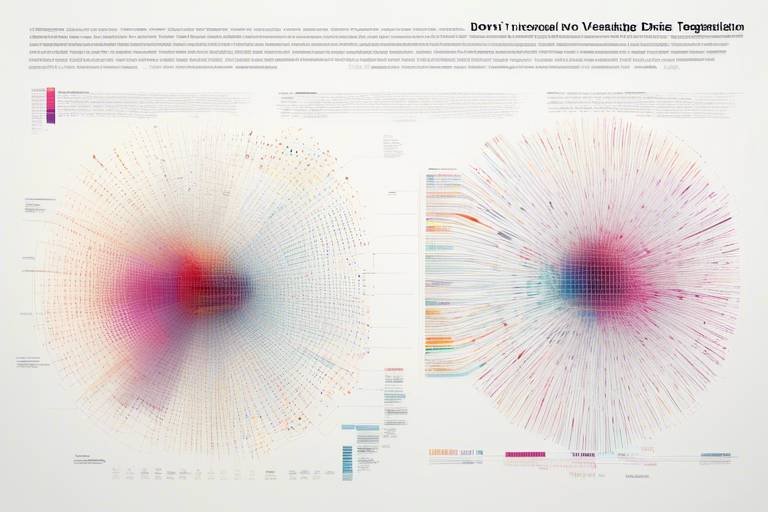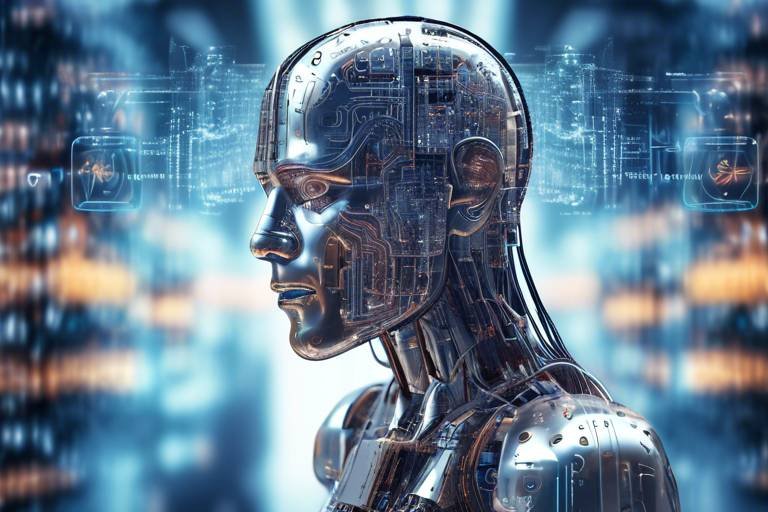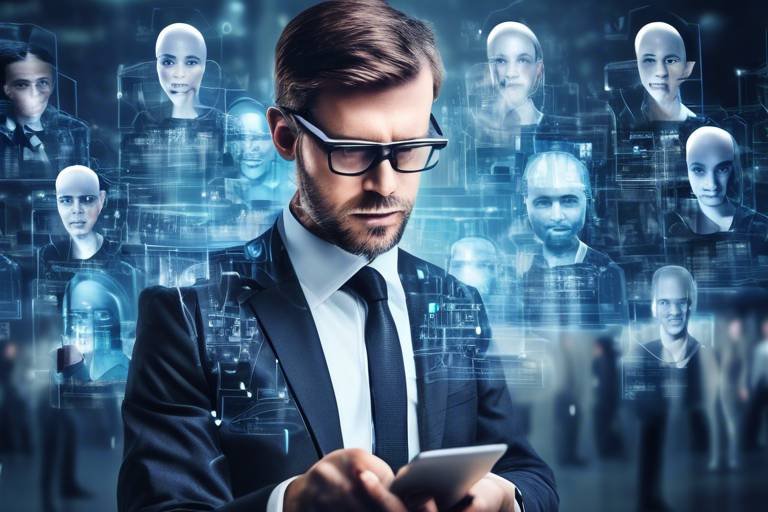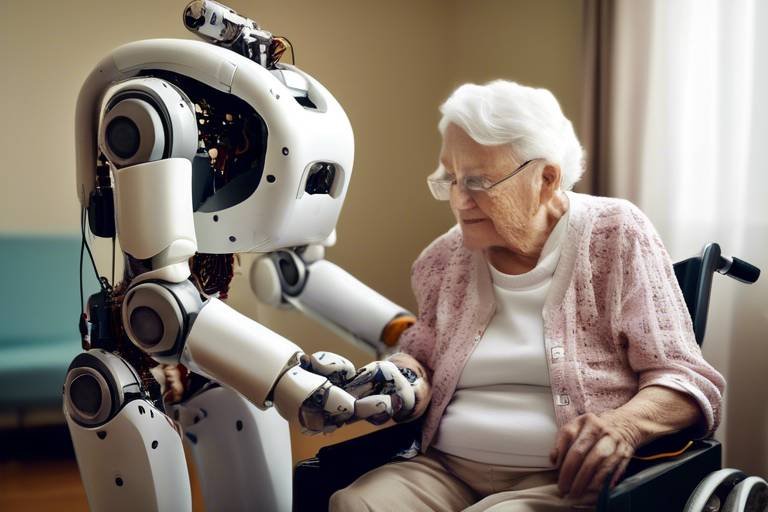How Digital Twins are Revolutionizing Industries
In today’s fast-paced world, where technology evolves at lightning speed, digital twins are making waves across various industries. But what exactly are they? Imagine having a virtual clone of a physical object or system that mirrors its real-time performance, behavior, and conditions. That’s the essence of digital twins! They enable businesses to simulate, analyze, and optimize their operations like never before, leading to groundbreaking improvements in efficiency, innovation, and decision-making.
Digital twins are not just a fleeting trend; they represent a paradigm shift in how industries operate. From manufacturing to healthcare, these virtual models are transforming traditional practices into highly efficient, data-driven processes. Think of digital twins as the ultimate cheat sheet for businesses—allowing them to predict outcomes, troubleshoot issues before they escalate, and even enhance customer experiences. The potential applications are practically limitless!
As we delve deeper into the world of digital twins, we’ll explore their components, significance, and the myriad ways they are revolutionizing various sectors. Whether you’re a tech enthusiast, a business leader, or someone curious about the future of technology, this journey into the realm of digital twins promises to be enlightening. Buckle up, because the future is here, and it’s digital!
At its core, a digital twin is a virtual representation of a physical entity. This can be anything from a manufacturing machine to an entire city. By utilizing real-time data, digital twins allow for continuous monitoring and analysis, leading to better decision-making and efficiency. The components of a digital twin typically include:
- Physical Entity: The real-world object that is being replicated.
- Data Connection: Sensors and IoT devices that gather data from the physical entity.
- Virtual Model: The digital representation that processes the data and simulates the physical entity's behavior.
- Analytics: Tools and algorithms that analyze the data to provide insights.
The significance of digital twins in modern industrial practices cannot be overstated. They enable organizations to gain insights into their operations, predict failures, and make informed decisions quickly. This level of insight was previously unattainable, making digital twins a game-changer in various sectors.
In the manufacturing sector, digital twins are proving to be invaluable. They help optimize processes, improve product design, and enhance supply chain management. For instance, consider a factory that employs digital twins to monitor machinery performance in real-time. If a machine is showing signs of wear and tear, the digital twin can alert operators before a breakdown occurs, minimizing downtime and preventing costly repairs.
One of the most significant applications of digital twins in manufacturing is predictive maintenance. This approach leverages real-time data to foresee equipment failures before they happen. By analyzing patterns and trends, manufacturers can schedule maintenance activities at the most opportune times, thereby:
- Reducing unplanned downtime.
- Extending the lifespan of machinery.
- Enhancing overall operational efficiency.
Implementing predictive maintenance through digital twins can lead to substantial cost savings. Businesses can save thousands of dollars by avoiding unexpected breakdowns and optimizing maintenance schedules. The return on investment (ROI) for adopting this technology can be remarkable, making it a wise choice for companies looking to enhance their bottom line.
Digital twins also play a crucial role in enhancing workplace safety. By predicting potential hazards and simulating various scenarios, organizations can create safer operational environments. With real-time monitoring, companies can respond swiftly to any safety concerns, ensuring the well-being of their employees.
When it comes to product development, digital twins are a game-changer. They allow for rapid prototyping and testing, meaning products can be designed, tested, and refined in a virtual environment before ever hitting the production line. This accelerates innovation and significantly reduces the time-to-market. Imagine being able to tweak a product design in seconds rather than weeks—this is the power of digital twins!
Digital twins are not just confined to manufacturing; they are also making a significant impact in the healthcare sector. By creating personalized patient models, healthcare providers can tailor treatment plans to individual needs, leading to improved patient outcomes. This innovative approach streamlines clinical processes and enhances the overall quality of care.
Continuous patient monitoring is another area where digital twins shine. By collecting real-time data from patients, healthcare professionals can intervene promptly when issues arise. This proactive approach not only enhances the quality of care but also significantly improves patient safety.
The drug development process is notoriously lengthy and costly, but digital twins are changing that narrative. By simulating drug interactions and patient responses, researchers can expedite the R&D process, bringing new treatments to market faster and more efficiently. This capability could revolutionize how we approach drug discovery and patient care.
1. What industries can benefit from digital twins?
Almost any industry can benefit from digital twins, including manufacturing, healthcare, transportation, and smart cities.
2. How do digital twins improve efficiency?
They provide real-time data analysis and simulations, allowing businesses to optimize processes and predict failures.
3. Are digital twins expensive to implement?
While there may be initial costs, the long-term savings and efficiency gains often outweigh these expenses.
4. Can digital twins be used for environmental monitoring?
Absolutely! Digital twins can simulate environmental conditions and help in managing resources effectively.

[Understanding Digital Twins]
In today's fast-paced technological landscape, the concept of digital twins has emerged as a game-changer across numerous industries. But what exactly are digital twins? At their core, digital twins are virtual replicas of physical entities, whether they be products, processes, or systems. They serve as a bridge between the physical and digital worlds, allowing for real-time data analysis and simulation. Imagine having a digital version of your car that not only mirrors its physical attributes but also tracks its performance metrics, predicts maintenance needs, and even suggests improvements.
The significance of digital twins goes beyond mere representation. They encompass a variety of components, including sensors, data analytics, and machine learning algorithms, all working in harmony to create a comprehensive digital model. This model can simulate real-world conditions, enabling industries to test scenarios without the risks associated with physical experimentation. For instance, in manufacturing, a digital twin of a production line can help identify bottlenecks and optimize workflows, ultimately enhancing efficiency and productivity.
Moreover, the applications of digital twins are vast and varied. From monitoring the health of industrial machinery to creating personalized healthcare solutions, the potential is enormous. Companies are increasingly leveraging these technologies to not only improve operational efficiency but also to drive innovation. In a world where data is king, digital twins empower businesses to make informed decisions based on real-time insights.
To better understand the impact of digital twins, let’s consider the following key areas:
- Real-time Monitoring: Digital twins allow for continuous observation of physical assets, providing valuable insights into their performance.
- Data-Driven Decision Making: By analyzing data from digital twins, organizations can make proactive decisions that enhance operational efficiency.
- Cost Efficiency: Reducing the need for physical prototypes and minimizing downtime can lead to significant cost savings.
In summary, digital twins are revolutionizing how industries operate by integrating the physical and digital realms. They not only facilitate better understanding and management of assets but also pave the way for future innovations that can transform entire sectors. As we delve deeper into the applications and benefits of digital twins in various industries, it becomes evident that this technology is not just a trend—it's a significant leap forward in industrial practices.

[Applications in Manufacturing]
The manufacturing sector is undergoing a profound transformation, and at the heart of this revolution are digital twins. These virtual replicas of physical systems enable manufacturers to optimize processes, enhance product designs, and streamline supply chain management. Imagine having a digital version of your factory floor that allows you to run simulations, test different scenarios, and predict outcomes without ever interrupting actual production. This is the power of digital twins, and their applications in manufacturing are both diverse and impactful.
One of the most significant advantages of implementing digital twins in manufacturing is their ability to provide real-time insights into operations. For instance, by integrating sensors and IoT devices, manufacturers can create a digital twin that reflects the current state of machinery, inventory levels, and production rates. This data-driven approach allows for informed decision-making, enabling managers to identify bottlenecks and inefficiencies quickly. A classic example can be seen in the automotive industry, where companies like Ford and BMW have adopted digital twin technology to enhance their production lines. By simulating various production scenarios, they can optimize workflows, reduce waste, and improve overall efficiency.
Predictive maintenance is another critical application of digital twins in manufacturing. By continuously monitoring equipment performance through their digital counterparts, manufacturers can predict when a machine is likely to fail. This proactive approach minimizes downtime, ultimately extending the lifespan of machinery and saving costs. For example, General Electric uses digital twins to monitor the health of their jet engines, allowing them to perform maintenance only when necessary, thus avoiding costly repairs and operational disruptions.
Moreover, the impact of digital twins extends beyond just maintenance. They also play a crucial role in product development. By creating virtual prototypes, companies can test and refine their products before they ever hit the production line. This not only accelerates the innovation process but also reduces time-to-market significantly. For instance, Siemens has leveraged digital twins in their product design process, allowing engineers to simulate the performance of new products under various conditions. This capability leads to better designs, fewer defects, and ultimately, higher customer satisfaction.
The integration of digital twins into supply chain management is yet another game changer. By having a digital representation of the entire supply chain, manufacturers can track inventory levels, monitor supplier performance, and manage logistics more effectively. This holistic view allows for better forecasting and planning, helping to ensure that the right products are available at the right time. Companies like Unilever have successfully implemented digital twin technology to optimize their supply chains, resulting in improved efficiency and reduced operational costs.
In summary, digital twins are not just a passing trend; they are a fundamental shift in how manufacturing operates. Their ability to provide real-time data, predict maintenance needs, accelerate product development, and optimize supply chains makes them invaluable in today’s competitive landscape. As more manufacturers embrace this technology, we can expect to see a significant increase in productivity, cost savings, and innovation across the industry.

[Predictive Maintenance]
Imagine a world where machines tell you when they need a check-up, just like how your car might alert you when it’s time for an oil change. This is the essence of predictive maintenance, a game-changing application of digital twin technology that allows businesses to anticipate equipment failures before they disrupt operations. By creating a virtual model of physical assets, organizations can continuously analyze performance data, identifying patterns that indicate potential malfunctions. This proactive approach not only minimizes unexpected downtime but also extends the lifespan of machinery, leading to a smoother operational flow.
So, how does this all work? The magic lies in the integration of sensors and real-time data analytics. Digital twins collect data from various sources—think of temperature readings, vibration levels, and operational speeds—feeding this information back to the virtual model. With sophisticated algorithms, the model can predict when a piece of equipment is likely to fail, allowing maintenance teams to intervene before a breakdown occurs. This is akin to having a crystal ball that reveals the future of your machinery, enabling you to plan maintenance schedules with precision.
The benefits of predictive maintenance are numerous. Here are a few key advantages:
- Reduced Downtime: By addressing issues before they escalate, companies can avoid costly production halts.
- Increased Equipment Lifespan: Regular maintenance based on predictive insights can prolong the life of machinery.
- Enhanced Safety: Predictive maintenance helps ensure that equipment operates within safe parameters, reducing the risk of accidents.
To illustrate the effectiveness of predictive maintenance, consider a manufacturing plant that implemented a digital twin system. Before this technology, the plant faced frequent unplanned shutdowns due to equipment failures, leading to significant losses. After adopting predictive maintenance, the plant saw a remarkable 30% reduction in downtime within the first year. This not only improved productivity but also boosted employee morale, as workers felt more secure knowing that potential issues were being monitored and addressed proactively.
In addition to these operational benefits, predictive maintenance also translates into substantial cost savings. By avoiding the high costs associated with emergency repairs and production delays, businesses can redirect funds towards innovation and growth. A recent study revealed that companies utilizing predictive maintenance strategies experienced an average 10-20% reduction in maintenance costs, making a compelling case for the adoption of this technology.
Moreover, the safety aspect cannot be overlooked. In industries where heavy machinery and complex operations are the norm, the stakes are high. Predictive maintenance contributes to a safer workplace by monitoring equipment conditions and alerting operators to potential hazards. For instance, if a machine begins to vibrate excessively, the digital twin can signal that something is amiss, prompting immediate inspection and reducing the likelihood of accidents. This not only protects employees but also safeguards the company from costly liability claims.
In summary, predictive maintenance powered by digital twins is revolutionizing the way industries approach equipment management. By leveraging real-time data and advanced analytics, businesses can enhance operational efficiency, cut costs, and create safer work environments. As technology continues to evolve, the potential for predictive maintenance to drive further innovations in various sectors remains limitless. Are you ready to embrace this transformative approach?
Q1: What is predictive maintenance?
Predictive maintenance is a proactive approach to maintenance that utilizes data analytics and digital twin technology to predict when equipment is likely to fail, allowing for timely interventions.
Q2: How does predictive maintenance save money?
By preventing unexpected equipment failures and minimizing downtime, predictive maintenance helps businesses avoid costly repairs and production delays, leading to significant cost savings.
Q3: Can predictive maintenance improve safety?
Yes! Predictive maintenance enhances workplace safety by monitoring equipment conditions and alerting operators to potential hazards, reducing the risk of accidents.

[Cost Savings]
When it comes to implementing predictive maintenance through digital twins, the financial implications can be nothing short of astounding. Imagine a scenario where your machinery is constantly monitored, and potential failures are predicted before they even happen. This proactive approach not only minimizes unexpected downtime but also significantly reduces repair costs. By addressing issues before they escalate, companies can save thousands, if not millions, of dollars over time.
To illustrate the potential savings, let’s consider a manufacturing plant that employs digital twins for predictive maintenance. According to industry studies, businesses that adopt this technology can see a reduction in maintenance costs by up to 30%. Additionally, the overall equipment effectiveness (OEE) can improve by as much as 15%, leading to increased productivity and profitability. Here’s a quick breakdown of how these savings can manifest:
| Cost Category | Traditional Maintenance | Predictive Maintenance with Digital Twins |
|---|---|---|
| Maintenance Costs | $100,000 | $70,000 |
| Downtime Costs | $50,000 | $20,000 |
| Total Cost | $150,000 | $90,000 |
As you can see from the table above, the shift from traditional maintenance approaches to a digital twin-driven strategy can lead to substantial cost reductions. But it’s not just about saving money; it’s also about enhancing the return on investment (ROI). Companies that invest in digital twins for predictive maintenance often recoup their initial investment within a year due to these savings.
Moreover, the savings extend beyond just direct costs. By utilizing digital twins, businesses can allocate resources more efficiently, reducing the need for excessive inventory and minimizing waste. This leads to a more streamlined operation where every dollar spent is maximized, ensuring that companies can invest more in innovation and growth.
In conclusion, the cost savings associated with implementing predictive maintenance through digital twins are significant and multifaceted. From reducing maintenance and downtime costs to improving overall operational efficiency, the financial benefits are clear. Companies that embrace this technology not only enhance their bottom line but also position themselves as leaders in their respective industries, ready to tackle the challenges of tomorrow.
- What are digital twins? Digital twins are virtual representations of physical assets, systems, or processes that allow for real-time monitoring and analysis.
- How do digital twins contribute to cost savings? They enable predictive maintenance, which reduces downtime and maintenance costs, leading to significant financial savings.
- Can digital twins be used in industries other than manufacturing? Absolutely! Digital twins are applicable in various sectors, including healthcare, automotive, and energy.
- What is predictive maintenance? Predictive maintenance is a proactive maintenance strategy that uses data and analytics to predict when equipment failures might occur, allowing for timely interventions.

[Improved Safety]
In today's fast-paced industrial landscape, safety is paramount. Digital twins are stepping up to the plate, bringing a new level of assurance to workplace environments. By creating virtual replicas of physical assets, companies can monitor conditions in real-time, allowing them to predict and mitigate risks before they escalate into serious incidents. Imagine having a digital guardian that keeps an eye on every piece of machinery, alerting you to potential hazards before they can cause harm. This proactive approach not only enhances safety but also fosters a culture of awareness among employees.
One of the standout features of digital twins is their ability to simulate various scenarios. For instance, if a manufacturing plant is considering a new layout, the digital twin can model how different configurations might impact worker safety. This simulation can reveal potential bottlenecks or hazardous situations that might not be immediately apparent in the physical world. By addressing these issues during the planning phase, companies can create safer work environments from the get-go.
Furthermore, digital twins can integrate data from multiple sources, such as sensors and IoT devices, to provide a comprehensive view of operational safety. This integration enables real-time alerts for unsafe conditions, such as equipment overheating or unusual vibrations, which could indicate impending failure. By acting on these alerts swiftly, businesses can prevent accidents and protect their workforce. The result? A significant reduction in workplace injuries and an overall boost in employee morale.
To illustrate the impact of digital twins on safety, consider the following table that summarizes key benefits:
| Benefit | Description |
|---|---|
| Real-Time Monitoring | Continuous tracking of equipment and environmental conditions to detect anomalies. |
| Predictive Alerts | Notifications about potential hazards or equipment failures before they occur. |
| Scenario Simulation | Modeling different operational scenarios to identify safety risks. |
| Data Integration | Combining data from various sources for a holistic view of safety. |
In conclusion, the integration of digital twins in industrial settings is not just a technological advancement; it represents a fundamental shift in how businesses approach safety. By leveraging real-time data and simulations, organizations can create safer workplaces, reduce risks, and ultimately protect their most valuable asset: their employees. As companies continue to embrace this innovative technology, the future of industrial safety looks brighter than ever.
- What are digital twins?
Digital twins are virtual replicas of physical entities that allow for real-time data analysis and simulation. - How do digital twins improve safety?
They provide real-time monitoring, predictive alerts for potential hazards, and scenario simulations to identify risks. - Can digital twins be used in all industries?
Yes, digital twins can be applied across various sectors, including manufacturing, healthcare, and logistics. - What are the financial benefits of implementing digital twins?
They can lead to reduced downtime, lower maintenance costs, and improved operational efficiency.

[Product Development]
In the fast-paced world of product development, digital twins are proving to be a game-changer. Imagine being able to create a virtual version of your product before it even hits the production line. This is precisely what digital twins allow innovators and engineers to do. By simulating real-world conditions and behaviors, teams can test and refine their designs in a virtual environment, leading to quicker iterations and ultimately, a more polished final product.
One of the most significant advantages of using digital twins in product development is the ability to conduct rapid prototyping. Instead of spending months building physical prototypes, teams can create digital replicas that mimic the product's performance. This means they can identify potential issues early on, saving time and resources. For example, a company designing a new electronic device can simulate how its components will function together, allowing them to tweak the design before committing to costly manufacturing processes.
Moreover, digital twins facilitate collaborative innovation. Teams spread across different locations can access the same digital model, enabling real-time feedback and adjustments. This collaboration can lead to more creative solutions and faster problem-solving. Imagine a team of engineers, designers, and marketers all working together on a digital platform, sharing insights, and making decisions based on the same data. It's like having a virtual brainstorming session that transcends geographical barriers.
To illustrate the impact of digital twins on product development, consider the automotive industry. Major car manufacturers are using digital twins to simulate vehicle performance, safety, and even consumer behavior. This approach allows them to understand how a car will perform under various conditions before it ever rolls off the assembly line. The result? Safer, more efficient vehicles that meet consumer expectations right from the start.
Furthermore, digital twins expedite the time-to-market for new products. By leveraging these advanced simulations, companies can reduce the lead time significantly. In today's competitive landscape, being first to market can make a world of difference. Companies that embrace digital twins can respond to market demands faster than their competitors, positioning themselves as leaders in their field.
In conclusion, the integration of digital twins into product development processes is not just a trend; it's a necessity for businesses looking to innovate and excel. With the ability to simulate, collaborate, and accelerate, digital twins are paving the way for a future where product development is more efficient, effective, and aligned with customer needs.
- What are digital twins? Digital twins are virtual replicas of physical entities that allow for real-time data analysis and simulation, enhancing decision-making and operational efficiency.
- How do digital twins improve product development? They enable rapid prototyping, collaborative innovation, and reduce time-to-market, allowing teams to test and refine designs before physical production.
- Can digital twins be used in other industries? Yes, digital twins have applications across various sectors, including manufacturing, healthcare, and automotive, among others.
- What are the benefits of using digital twins? Benefits include cost savings, improved safety, enhanced collaboration, and accelerated innovation.

[Impact on Healthcare]
In the ever-evolving landscape of healthcare, the introduction of digital twins is nothing short of revolutionary. Imagine having a virtual model of a patient that mirrors their physiological characteristics, health conditions, and even their response to treatments. This is precisely what digital twins offer—an incredible opportunity to enhance patient care and streamline clinical processes. By creating personalized patient models, healthcare providers can tailor treatments to individual needs, ensuring that each patient receives the best possible care.
One of the most significant advantages of digital twins in healthcare is their ability to facilitate continuous patient monitoring. With real-time data collection, healthcare professionals can keep tabs on a patient's vital signs, medication adherence, and overall health status. This proactive approach allows for timely interventions, potentially preventing complications before they escalate. For instance, if a digital twin indicates a sudden spike in blood pressure, healthcare providers can intervene immediately, adjusting treatment plans or medications accordingly. This level of responsiveness is crucial in improving patient outcomes and enhancing the quality of care.
Moreover, digital twins are making waves in the realm of drug development. The traditional drug development process is often lengthy and fraught with uncertainty. However, by simulating drug interactions and patient responses using digital twins, researchers can expedite the research and development phase significantly. This technology allows for a more efficient testing environment, where various drug formulations can be assessed in a virtual setting before moving to clinical trials. As a result, pharmaceutical companies can bring effective therapies to market faster, ultimately benefiting patients in need of new treatment options.
To illustrate the transformative potential of digital twins in healthcare, consider the following table that highlights key applications and their impacts:
| Application | Impact |
|---|---|
| Personalized Treatment Plans | Improved patient outcomes through tailored therapies. |
| Continuous Monitoring | Timely interventions that prevent complications. |
| Drug Development | Accelerated research leading to faster market availability. |
| Predictive Analytics | Anticipation of health issues before they arise. |
In conclusion, the impact of digital twins on healthcare is profound and far-reaching. As we continue to harness the power of this technology, we can expect to see dramatic improvements in patient care, operational efficiency, and overall health outcomes. The future of healthcare is not just about treating illnesses; it's about creating a more personalized, proactive, and efficient system that ultimately leads to healthier lives.
- What are digital twins? Digital twins are virtual replicas of physical entities, allowing for real-time data analysis and simulation.
- How do digital twins improve patient care? They enable personalized treatment plans and continuous monitoring, leading to better health outcomes.
- Can digital twins speed up drug development? Yes, they allow researchers to simulate drug interactions and patient responses, expediting the research process.
- What industries benefit from digital twins? While healthcare is a significant sector, industries like manufacturing, automotive, and aerospace also leverage digital twins for efficiency.

[Patient Monitoring]
In the ever-evolving landscape of healthcare, patient monitoring has taken on a new dimension thanks to the advent of digital twins. Imagine having a virtual version of a patient that mirrors their real-time health data, allowing healthcare professionals to monitor their condition continuously. This revolutionary approach not only enhances the quality of care but also empowers medical teams to make informed decisions at lightning speed. With the integration of digital twin technology, the days of waiting for lab results or relying solely on periodic check-ups are fading into obscurity.
One of the most significant advantages of digital twins in patient monitoring is their ability to facilitate continuous data collection. By utilizing wearable devices and smart sensors, healthcare providers can gather critical health metrics such as heart rate, blood pressure, and oxygen levels in real time. This constant stream of data allows for immediate responses to any concerning changes in a patient's condition. For instance, if a patient's heart rate spikes unexpectedly, the digital twin can alert healthcare professionals, enabling swift intervention before a situation escalates.
Moreover, the integration of artificial intelligence (AI) with digital twins enhances predictive analytics, allowing for early detection of potential health issues. By analyzing trends and patterns in the data, AI can forecast possible complications and suggest preventive measures. This proactive approach not only improves patient safety but also significantly reduces the risk of hospital readmissions. Imagine a world where a patient’s risk of a heart attack could be predicted and mitigated before it ever occurs. That’s the promise of digital twin technology!
To illustrate the impact of digital twins on patient monitoring, consider the following table, which summarizes key benefits and features:
| Benefit | Description |
|---|---|
| Real-Time Monitoring | Continuous tracking of vital signs and health metrics through connected devices. |
| Predictive Analytics | Utilizing AI to forecast potential health risks based on historical data. |
| Personalized Care | Tailoring treatment plans based on individual patient data and responses. |
| Enhanced Communication | Facilitating better collaboration among healthcare providers through shared data. |
Furthermore, the impact of digital twins extends beyond just monitoring. They also play a crucial role in patient education and engagement. By providing patients with access to their own health data through user-friendly applications, individuals become more involved in their healthcare journey. They can visualize how lifestyle changes, medications, or therapies affect their health, fostering a sense of ownership and encouraging adherence to treatment plans.
In conclusion, the integration of digital twins into patient monitoring is a game-changer in the healthcare industry. It not only enhances the quality of care but also transforms the patient experience, making healthcare more personalized, proactive, and efficient. As technology continues to advance, we can only imagine the incredible possibilities that lie ahead for patient monitoring and overall health management.
- What are digital twins in healthcare? Digital twins in healthcare are virtual replicas of patients that use real-time data to monitor health conditions and predict potential issues.
- How do digital twins improve patient safety? They enhance patient safety by providing continuous monitoring and predictive analytics, allowing for timely interventions.
- Can patients interact with their digital twins? Yes, patients can access their health data through applications, promoting engagement and informed decision-making.
- What technologies are used in digital twins for patient monitoring? Wearable devices, smart sensors, and AI algorithms are commonly used to create and maintain digital twins.

[Drug Development]
When it comes to drug development, the stakes are incredibly high. The process is not only time-consuming but also fraught with challenges that can lead to costly failures. Here’s where digital twins step in, acting like a superhero in the pharmaceutical realm. By creating virtual representations of biological systems, researchers can simulate how drugs will interact with the body, allowing for a more targeted approach to treatment development.
Imagine trying to navigate a maze blindfolded; that’s akin to traditional drug development. However, with digital twins, researchers can remove the blindfold, gaining a clear view of potential pathways and outcomes. This technology allows scientists to create detailed models of individual patients, including their genetic makeup, medical history, and even lifestyle factors. Such personalized models enable a deeper understanding of how different patients might respond to a particular drug.
One of the most exciting aspects of using digital twins in drug development is the ability to conduct simulations that predict how a drug will behave in the human body. This can significantly reduce the need for extensive clinical trials, which are not only expensive but also time-consuming. Instead, researchers can run various scenarios using the digital twin models to observe potential side effects or efficacy before moving forward with real-world testing.
To illustrate this, consider the following table that outlines the traditional drug development process versus the enhanced approach using digital twins:
| Phase | Traditional Approach | Digital Twin Approach |
|---|---|---|
| Initial Research | Labor-intensive, high failure rate | Data-driven insights, lower failure rate |
| Clinical Trials | Long duration, costly | Shortened duration, reduced costs |
| Post-Market Surveillance | Reactive monitoring | Proactive risk assessment |
Moreover, digital twins facilitate collaborative research across different institutions. By sharing data and insights derived from these virtual models, pharmaceutical companies can accelerate the discovery of new drugs and improve existing ones. This collaborative approach not only enhances innovation but also fosters a sense of community among researchers, ultimately leading to better patient outcomes.
In summary, digital twins are transforming the landscape of drug development. They provide a powerful tool for simulating drug interactions and patient responses, significantly speeding up the research process while reducing costs. As this technology continues to evolve, we can expect even more breakthroughs in how we approach drug development, paving the way for more effective and personalized treatments.
- What are digital twins? Digital twins are virtual replicas of physical entities that allow for real-time data analysis and simulation.
- How do digital twins benefit drug development? They enable researchers to simulate drug interactions and patient responses, reducing the need for extensive clinical trials.
- Can digital twins improve patient outcomes? Yes, by allowing for personalized treatment plans based on virtual models of individual patients.
- Are digital twins expensive to implement? While there is an initial investment, the long-term cost savings and efficiency gains often outweigh the costs.
Frequently Asked Questions
-
What exactly are digital twins?
Digital twins are virtual replicas of physical entities, such as machines, systems, or even entire factories. They allow for real-time data analysis and simulation, making it easier to understand and optimize performance through continuous monitoring and adjustments.
-
How are digital twins used in manufacturing?
In manufacturing, digital twins optimize processes by providing insights into production lines, improving product design, and enhancing supply chain management. They help identify inefficiencies and enable manufacturers to make data-driven decisions that boost productivity and reduce costs.
-
Can digital twins help with predictive maintenance?
Absolutely! Digital twins play a crucial role in predictive maintenance by simulating equipment conditions and predicting potential failures before they occur. This proactive approach minimizes downtime, extends machinery lifespan, and ultimately saves money for businesses.
-
What are the cost benefits of using digital twins?
Implementing digital twins can lead to significant cost savings, especially through predictive maintenance and optimized operations. Businesses can expect a strong return on investment as they reduce unexpected repairs and improve overall efficiency.
-
How do digital twins enhance safety in workplaces?
Digital twins enhance workplace safety by predicting potential hazards and allowing for real-time monitoring of equipment and environments. This technology helps create safer operational conditions by simulating various scenarios and preparing for potential risks.
-
What role do digital twins play in healthcare?
In healthcare, digital twins create personalized patient models that help in treatment planning and improve patient outcomes. They facilitate continuous monitoring and provide healthcare professionals with critical insights for timely interventions.
-
How do digital twins assist in drug development?
Digital twins are revolutionizing drug development by simulating drug interactions and patient responses. This technology expedites research and development processes, allowing for faster and more effective pharmaceutical innovations.



















